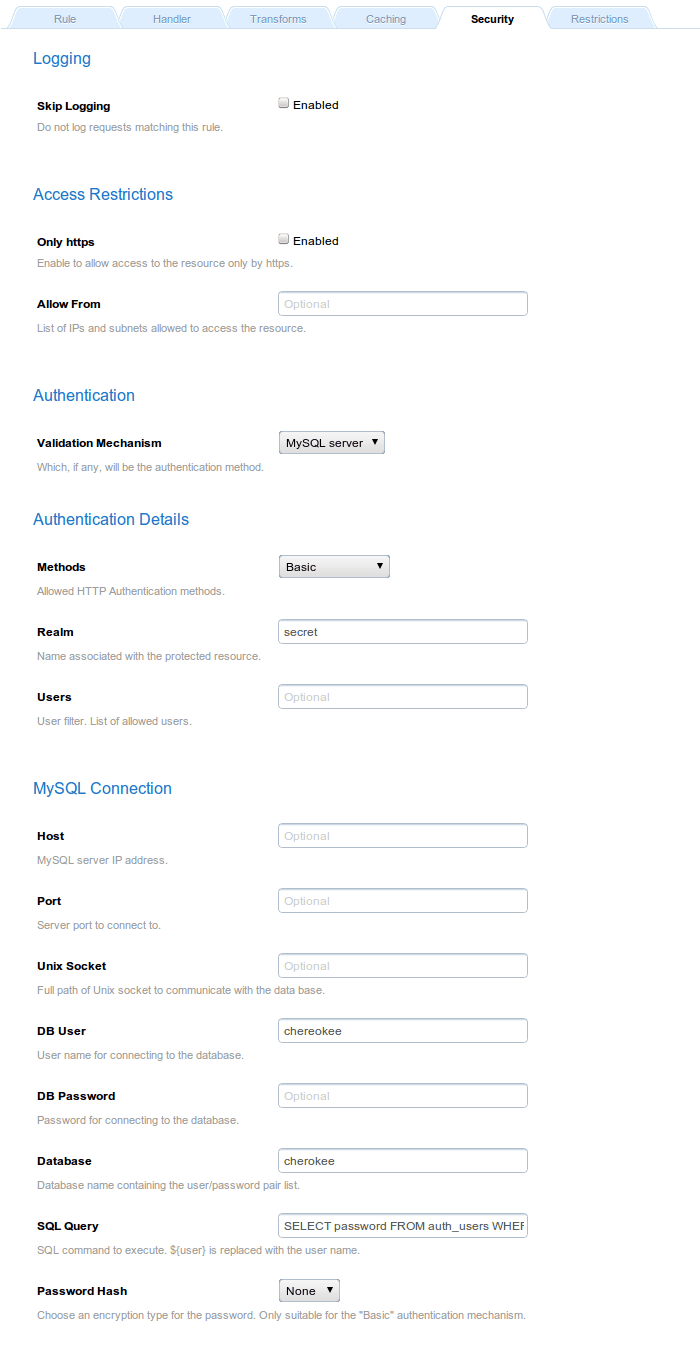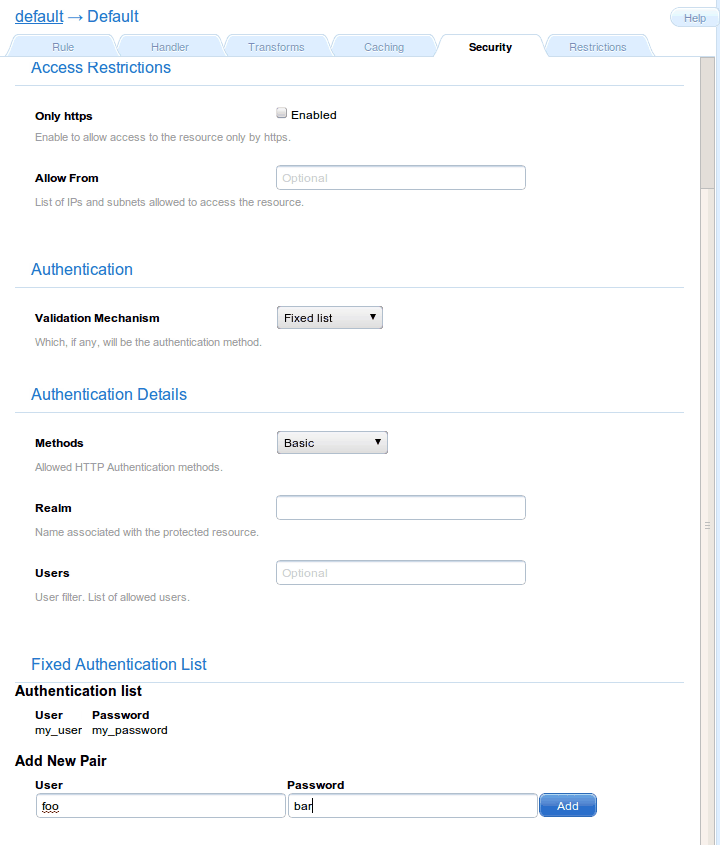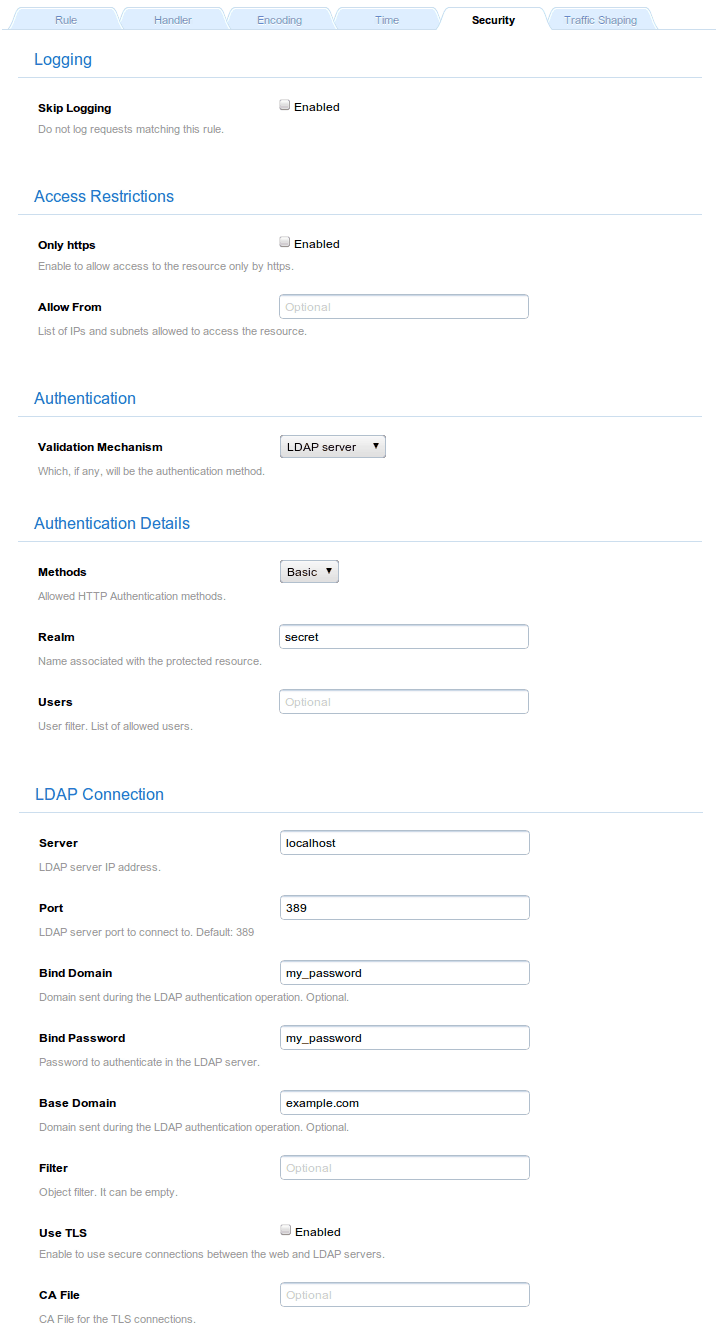$ htdigest -c passwords.digest secret testuser Adding password for testuser in realm secret. New password: Re-type new password: $ cat pass testuser:secret:f24f76261bcd65780b33edde00855897
Documentation
Cookbook: Authentication
In this section you will find information useful to set up authentication mechanisms with several of Cherokee’s validators.
You can find information and basic examples in each validator’s documentation. This is the list of validator modules provided by Cherokee:
You will also find interesting information in the "Validator Modules Overview" and step by step examples for Plain and PAM mechanisms in the "Quickstart" section.
There are two types of authentication:
- basic
-
This method sends the username and password in clear text over the network. It is not the most secure method. If the connection to the web server is through HTTPS then this method is as secure as the encryption used. This method is very easy to implement, so most clients support it.
- digest
-
This method is by far the most secure, but also more complex. Most modern web browsers support this method.
The details to set up the ‘htdigest` and htpasswd are exactly the same as for plain validation. The only difference is the tools used to create the passwords’ file.
htdigest
To use this validator you will need a file created by the htdigest command. It is a tool to manage user files for digest (and basic) authentication.
To create a file for a testuser with testpassword you would have to issue:
htpasswd
For this validator, the tool htpasswd is needed to create the files. The basic usage information is this:
Refer to its documentation for details about the parameters. For our example, this will suffice:
$ htpasswd -c /var/www/.htpasswd testuser New password: Re-type new password: Adding password for user testuser $ cat /var/www/.htpasswd testuser:iqLGh2g/7bX7M
Remember that it is never recommended to place the file with the passwords in a location fetchable from the webserver. This is true for plain validation, htdigest, htpasswd and whatever file based system you cross paths with.
MySQL
Lets set up a simple server requiring authentication against a MySQL database to fetch any content.
First, lets define a unique rule in our virtual server managed by the List and Send handler. Through the Security tab we can configure it to use MySQL as authentication mechanism. Filling up just the essential fields will be enough. Those are realm, database name, user, password, and an SQL query that must return one row with one column as password.

In this case, we have used:
SELECT password FROM auth_users WHERE username = '${user}'
And that is about it. In this example you will need a MySQL server running (localhost in this case, as it takes the default value), a database called cherokee with cherokee as user and password, and a table that suits the shown query.
Assuming you have a MySQL user with privileges granted to create databases, a MySQL session similar to this one would suffice:
$ mysql -u cherokee -D cherokee -p
mysql> CREATE DATABASE cherokee;
Query OK, 1 row affected (0.00 sec)
mysql> CREATE TABLE auth_users(
username varchar(32),
password varchar(32),
PRIMARY KEY (username));
Query OK, 0 rows affected (0.00 sec)
mysql> INSERT INTO auth_users VALUES('cherokee','cherokee');
Query OK, 1 row affected (0.00 sec)
mysql> quit
When we are done, our simple virtual server should only have a Default rule, managed by the List & Send hander, and with MySQL authentication set.

And any content requested to Cherokee will require prior authentication against the database.
Another usage example
As you can see, getting the hang of how authentication works is pretty easy. Let’s illustrate another easy example. How to serve PHP files, both from a protected location and an unprotected one?
Let’s assume our locations are targets are: - /unprotected/.php - /protected/.php
Well… this would be really easy. You just have to remember that rules are evaluated from top to bottom, and the evaluation proceeds until a final rule is matched.
This means that we would only have to be careful with the order of our rules, and it would be as simple as setting a couple of rules:
-
The first one, of type Directory applied to the path /protected. This would be the top rule, should use one of the authentication mechanisms mentioned above and should not be set as FINAL.
-
The second one, of type Extension would apply to php files and should be configured as according to the PHP recipe. This one should be a FINAL rule.
And this would be more than enough. The files from the secure location would match the first rule and the authentication would be required. In case it was successful, not being a final rule, the request would proceed to the second rule. Once there, the regular processing of PHP files would take place. This one is a FINAL rule, so the rule evaluation would stop.
In case the PHP files were not being requested from the secured directory, just the second rule would apply.
Fixed list
For this validator you will only need to add user-password pairs, and the mandatory realm field.

LDAP
Here is a basic example of the LDAP validator in action. It assumes you have a working LDAP service running at your localhost, and it uses no TLS of CA files.
| Field | Value |
|---|---|
Validation Mechanism |
LDAP Server |
Methods |
Basic |
Realm |
secret |
Server |
localhost |
Port |
389 |
Bind Domain |
my_domain |
Bind Password |
my_password |
Base Domain |
example.com |

